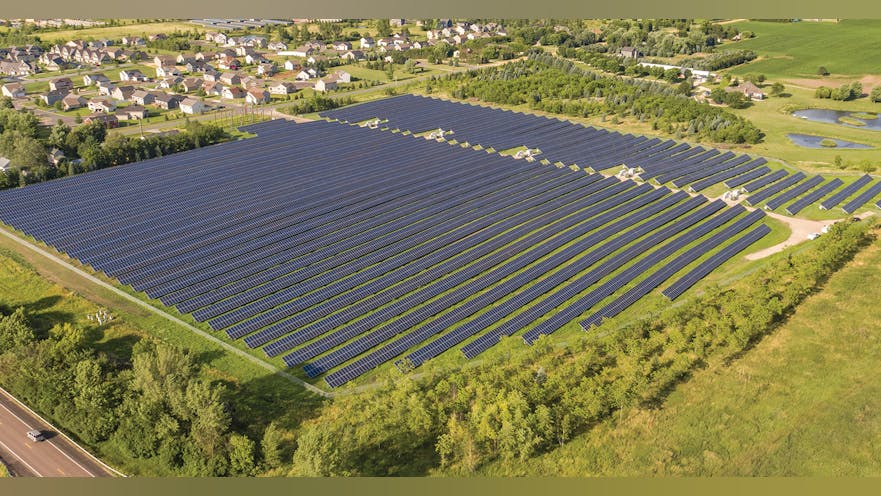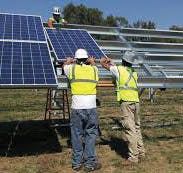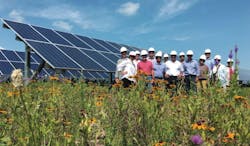Casting ferrous parts involves an array of well-established processes, and many of the technologies we have installed at Midwest Metal Products, Inc (MMP) will be familiar to many of our metalcasting colleagues. On the other hand, one of our installations will be surprising to most of them.
Midwest Metal Products is a steel and iron foundry in Winona, MN, and has become what I believe to be the only commercial foundry in North America fully powered by solar energy -- including the melting operations.
MMP has been on a progressive path since the current ownership group took over in 2013. The plant has the only microwave-powered foundry sand reclaimer in the country, in partnership with M-Wave Foundry Technologies, a prototype that has been testing sands for foundries across the country. MMP also has been active in the application of naturally pressurized gating, presenting “Air Entrainment: Testing the Model” at the 2017 Steel Founder’s Society National Technical and Operating Conference. The paper earned SDSA’s Robert G. Shepard “Best Paper” Award at the conference last December.
The MMP site has been home to an operating foundry since the 1950s. In the 1980s, the green-sand gray iron foundry was combined with a local heat-treating operation, and in 1991 president Howard Lambert introduced air-set molding and started to produce steel as well iron castings.
Now the plant runs both irons and a wide variety of steels using induction melting, with molten metal capacity of about 2,800 lbs. per heat. The melting capacity ultimately governs the sizes of the castings, from a few pounds up to 1,100 lbs. in steels, and 1,800 lbs. in irons. Molding is accomplished on three air-set lines arranged according to the size and volume of the cast parts that each one makes. MMP is a low- to medium-volume shop, making some parts once every few years, as well as some parts in volumes as high as 15,000 per year.
Cores are made in gas-cured phenolic urethane, air-set, shell, and oil sand to support the plant’s product mix. Pouring is a manual process using ladles of various capacity, due to the wide range of sizes and weights of the castings.
Cleaning is a manual operation too, with some mechanical equipment in place, and more planned. Heat treating is done for both our own products as well as commercial clients, employing our three primary furnaces and a number of tempering ovens.
MMP offers our clients many value-added services that are accomplished with the help of partner companies, involving machining, painting, certified testing, flame hardening, and other specialty treatments to parts we make.
MMP supplies a wide variety of ferrous-casting buyers across a range of markets, including mining, oil-and-gas, trenchless technology, agriculture, defense, large equipment OEMs, abrasive material handling, and many others. The firm-order backlog has grown by over 400% since mid-2016, and currently this number stands at its largest since the company inception.
At the moment MMP has no brick-and-mortar capital investment plans, but we’re working to maximize the available capacity of the current plant configuration while replacing/upgrading the infrastructure already in place.
The way that we power-up this operation is the development that may surprise some metalcasters. As an induction-melting foundry MMP is consuming some 2.7 megawatts of electricity annually from the standard regional energy grid. The internal electrical systems have been in place since 2013 when the current melt system was installed, and we have no near-term plans for significant changes.
In 2015 MMP was approached to participate in the Minnesota Community Solar Garden initiative, a cooperative program that coordinates placement of dense arrays of solar (PV) panels that generate electrical energy. The value of the energy generated is credited to the participating company.
The array is located so as to supply transformers connected to the regional grid, adding power to the existing transmission infrastructure and supplementing other sources of electrical power. In Minnesota, these “gardens” are typically 5-MW installations, in contrast to the large array installed by Xcel Energy in Chisago County that’s rated at 100 MW.
The MCSG developers used a listing of significant electrical consumers to pitch the idea of subscribing to a garden, and I was very interested from the start. The earth has a nearly inexhaustible source of energy via our relationship with the sun (radiant and gravity effects) so it just makes sense to try to harvest it as directly as we can. I also feel it is a good, environmentally responsible action, and it happens to make business sense as well.
In September 2013 Minnesota directed that large electrical providers must derive at least 1.5% of their total electricity supply from solar sources by 2020, from both energy companies’ large solar arrays and community solar garden projects. The state now hosts the largest community solar garden program in the country, with 58 projects as of December 2017 and 69 more scheduled to come online this year.
Minnesota was found to be a good location for this application due to topography and number of “sunny days,” however once all the filtering is applied to potential actual usable sites the numbers drop considerably. For example, among some 40,500 land parcels in Carver County, after for size, agriculture preservation, suitable land cover (not trees), wetland, and proximity to significant power transmission lines for the grid connection, only 128 sites (0.32% of the county) remained as potential development sites.
As the initiative evolved the decision was made to award “solar garden” developer permits to build gardens capable of generating 1 MW of power each, ultimately allowing up to five of these individual gardens to be on a single site to maximize the use of, and minimize the cost burden of, the connection that must be made to the current power grid. A single-megawatt garden will require about 2.5 acres of space to set the solar array.
Further, the developers were tasked with finding and securing “subscribers” to take the electricity generated by the gardens they were constructing: this ensured that the new electricity was in fact displacing demand that was being served by other means, and this hurdle had to be overcome to be able to proceed with construction of the gardens.
Among the rules surrounding these gardens was the stricture that no single subscriber could take more than 40% of the output of a single garden, and there had to be at least five subscribers to every garden.
With this framework, in mid-2016 MMP signed up as the anchor subscriber to four gardens, to get the full plant power requirement covered. The initiative used the subscriber’s previous two years of consumption to set a baseline and allowed any single subscriber to take up to 120% of that number. MMP is subscribed to just over 100% of that average with our four-garden arrangement.
Having been through many economic cycles over nearly 40 years in the foundry industry, I was confident of MMP’s growth following the lean years of 2015-2016, when shipments fell as much as 40% from 2014 levels. So, I wanted to be “boldly conservative” in my selection.
A number of different developers won the contracts to install gardens across many areas of Minnesota, and each developer was able to make individual contracts with subscribers using a variety of contract approaches. This ranges from fixed pricing that indexes from current energy rates strategy (MMP’s choice) to higher risk variable pricing. In every case, the subscriber has signed up to a 25-year contract with the garden developer. Ultimately, we forecast that MMP’s subscription will generate about $25,000 in annual savings at projected garden output or $625,000 over the life of the contract.
MMP’s solar gardens are operated by BHE Renewables. The gardens came on-line in February 2018 and have been sufficiently productive that MMP is selling some excess power back to the grid, in spite of a significant business increase. I don’t expect that to continue, as we are ramping up for higher production as the economy steadily expands and we secure new customers for our cast products. Because the gardens are feeding the larger grid, MMP sees absolutely no difference in the quality or availability of power for operations.
At this point Minnesota has limited the number of permits allowable to garden developers so the future availability of new garden subscriptions, and what those contracts may entail, is uncertain. I know that in other states the offering was not as attractive to subscribers, and perhaps it may happen that way in Minnesota, too.
But, MMP is very pleased to be in on the ground floor of this initiative, and it our outlook is that solar power will serve the plant very well into the future.
Joe Plunger is CEO of Midwest Metal Products, a steel and iron foundry in Winona, MN. Contact him at [email protected]











